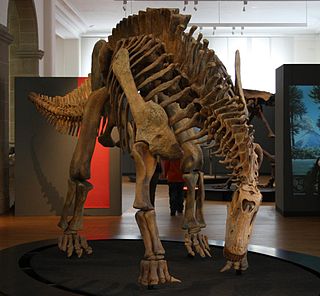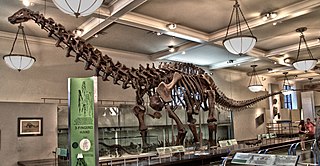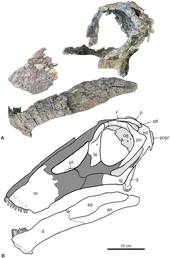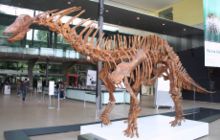
Barapasaurus is a genus of basal sauropod dinosaur from Jurassic rocks of India. The only species is B. tagorei. Barapasaurus comes from the lower part of the Kota Formation, which is of Early to Middle Jurassic age. It is therefore one of the earliest known sauropods. Barapasaurus is known from approximately 300 bones from at least six individuals, so that the skeleton is almost completely known except for the anterior cervical vertebrae and the skull. This makes Barapasaurus one of the most completely known sauropods from the early Jurassic.

Diplodocids, or members of the family Diplodocidae, are a group of sauropod dinosaurs. The family includes some of the longest creatures ever to walk the Earth, including Diplodocus and Supersaurus, some of which may have reached lengths of up to 42 metres (138 ft).

Amargasaurus is a genus of sauropod dinosaur from the Early Cretaceous epoch of what is now Argentina. The only known skeleton was discovered in 1984 and is virtually complete, including a fragmentary skull, making Amargasaurus one of the best-known sauropods of its epoch. Amargasaurus was first described in 1991 and contains a single known species, Amargasaurus cazaui. It was a large animal, but small for a sauropod, reaching 9 to 13 meters in length. Most distinctively, it sported two parallel rows of tall spines down its neck and back, taller than in any other known sauropod. In life, these spines could have stuck out of the body as solitary structures that supported a keratinous sheath. An alternate hypothesis, now more favored, postulates that they could have formed a scaffold supporting a skin sail. They might have been used for display, combat, or defense.
Suuwassea is a genus of dicraeosaurid sauropod dinosaur found in the Upper Jurassic strata of the Morrison Formation, located in southern Carbon County, Montana, United States. The fossil remains were recovered in a series of expeditions during a period spanning the years 1999 and 2000 and were described by J.D. Harris and Peter Dodson in 2004. They consist of a disarticulated but associated partial skeleton, including partial vertebral series and limb bones.

Dicraeosauridae is a family of diplodocoid sauropods who are the sister group to Diplodocidae. Dicraeosaurids are a part of the Flagellicaudata, along with Diplodocidae. Dicraeosauridae includes genera such as Amargasaurus, Suuwassea, Dicraeosaurus, and Brachytrachelopan. Specimens of this family have been found in North America, Asia, Africa, and South America. In 2023, a dicraeosaurid fossil was discovered in India for the first time. Their temporal range is from the Early or Middle Jurassic to the Early Cretaceous. Few dicraeosaurids survived into the Cretaceous, the youngest of which was Amargasaurus.

Brachytrachelopan is a short-necked sauropod dinosaur from the Late Jurassic of Argentina. The holotype and only known specimen was collected from an erosional exposure of fluvial sandstone within the Cañadón Calcáreo Formation on a hill approximately 25 kilometres (16 mi) north-northeast of Cerro Cóndor, Chubut Province, in west-central Argentina, South America. Though very incomplete, the skeletal elements recovered were found in articulation and include eight cervical, twelve dorsal, and three sacral vertebrae, as well as proximal portions of the posterior cervical ribs and all the dorsal ribs, the distal end of the left femur, the proximal end of the left tibia, and the right ilium. Much of the specimen was probably lost to erosion many years before its discovery. The type species is Brachytrachelopan mesai. The specific name honours Daniel Mesa, a local shepherd who discovered the specimen while searching for lost sheep. The genus name translates as "short-necked Pan", Pan being the god of the shepherds.

Australodocus is a genus of sauropod dinosaur that lived during the Late Jurassic period, around 150 million years ago, in what is now Lindi Region, Tanzania. Though initially considered a diplodocid, recent analyses suggest it may instead be a titanosauriform.
Amargatitanis is a genus of dicraeosaurid sauropod dinosaur from the Barremian-age La Amarga Formation of Neuquén, Argentina. It is known from a single, incomplete postcranial skeleton consisting of a partial hindlimb, ischium, and two vertebrae. These remains were unearthed by Argentine paleontologist José Bonaparte in 1983 during an expedition by the Museo Argentino de Ciencias Naturales and later described as a new genus and species, Amargatitanis macni by Sebastián Apesteguía. The genus name comes from the words Amarga, where the fossils were collected, and titanis meaning "titan". Its species name is in reference to the MACN, where the remains are stored.

Apatosaurinae is a subfamily of diplodocid sauropods, an extinct group of large, quadrupedal dinosaurs, the other subfamily in Diplodocidae being Diplodocinae. Apatosaurines are distinguished by their more robust, stocky builds and shorter necks proportionally to the rest of their bodies. Several fairly complete specimens are known, giving a comprehensive view of apatosaurine anatomy.

Diplodocus was a genus of diplodocid sauropod dinosaurs, whose fossils were first discovered in 1877 by S. W. Williston. The generic name, coined by Othniel Charles Marsh in 1878, is a Neo-Latin term derived from Greek διπλός (diplos) "double" and δοκός (dokos) "beam", in reference to the double-beamed chevron bones located in the underside of the tail, which were then considered unique.

Brachiosaurus is a genus of sauropod dinosaur that lived in North America during the Late Jurassic, about 154 to 150 million years ago. It was first described by American paleontologist Elmer S. Riggs in 1903 from fossils found in the Colorado River valley in western Colorado, United States. Riggs named the dinosaur Brachiosaurus altithorax; the generic name is Greek for "arm lizard", in reference to its proportionately long arms, and the specific name means "deep chest". Brachiosaurus is estimated to have been between 18 and 22 meters long; body mass estimates of the subadult holotype specimen range from 28.3 to 46.9 metric tons. It had a disproportionately long neck, small skull, and large overall size, all of which are typical for sauropods. Atypically, Brachiosaurus had longer forelimbs than hindlimbs, which resulted in a steeply inclined trunk, and a proportionally shorter tail.

Nigersaurus is a genus of rebbachisaurid sauropod dinosaur that lived during the middle Cretaceous period, about 115 to 105 million years ago. It was discovered in the Elrhaz Formation in an area called Gadoufaoua, in Niger. Fossils of this dinosaur were first described in 1976, but it was only named Nigersaurus taqueti in 1999, after further and more complete remains were found and described. The genus name means "Niger reptile", and the specific name honours the palaeontologist Philippe Taquet, who discovered the first remains.

Spinophorosaurus is a genus of sauropod dinosaur that lived in what is now Niger during the Middle Jurassic period. The first two specimens were excavated in the 2000s by German and Spanish teams under difficult conditions. The skeletons were brought to Europe and digitally replicated, making Spinophorosaurus the first sauropod to have its skeleton 3D printed, and were to be returned to Niger in the future. Together, the two specimens represented most of the skeleton of the genus, and one of the most completely known basal sauropods of its time and place. The first skeleton was made the holotype specimen of the new genus and species Spinophorosaurus nigerensis in 2009; the generic name refers to what was initially thought to be spiked osteoderms, and the specific name refers to where it was found. A juvenile sauropod from the same area was later assigned to the genus.

Kaatedocus is a genus of flagellicaudatan sauropod known from the middle Late Jurassic of northern Wyoming, United States. It is known from well-preserved skull and cervical vertebrae which were collected in the lower part of the Morrison Formation. The type and only species is Kaatedocus siberi, described in 2012 by Emanuel Tschopp and Octávio Mateus.
This glossary explains technical terms commonly employed in the description of dinosaur body fossils. Besides dinosaur-specific terms, it covers terms with wider usage, when these are of central importance in the study of dinosaurs or when their discussion in the context of dinosaurs is beneficial. The glossary does not cover ichnological and bone histological terms, nor does it cover measurements.

Leinkupal is a genus of diplodocine sauropod known from the Early Cretaceous of the Bajada Colorada Formation, southeastern Neuquén Basin in the Neuquén Province of Argentina. It contains a single species, Leinkupal laticauda.

Patagotitan is a genus of titanosaurian sauropod dinosaur from the Cerro Barcino Formation in Chubut Province, Patagonia, Argentina. The genus contains a single species known from at least six young adult individuals, Patagotitan mayorum, which was first announced in 2014 and then named in 2017 by José Carballido and colleagues. Preliminary studies and press releases suggested that Patagotitan was the largest known titanosaur and land animal overall, with an estimated length of 37 m (121 ft) and an estimated weight of 69 tonnes. Later research revised the length estimate down to 31 m (102 ft) and weight estimates down to approximately 50–57 tonnes, suggesting that Patagotitan was of a similar size to, if not smaller than, its closest relatives Argentinosaurus and Puertasaurus. Still, Patagotitan is one of the most-known titanosaurs, and so its interrelationships with other titanosaurs have been relatively consistent in phylogenetic analyses. This led to its use in a re-definition of the group Colossosauria by Carballido and colleagues in 2022.

Galeamopus is a genus of herbivorous diplodocid sauropod dinosaurs. It contains two known species: Galeamopus hayi, known from the Late Jurassic lower Morrison Formation of Wyoming, United States, and Galeamopus pabsti, known from the Late Jurassic fossils from Wyoming and Colorado. The type species is known from one of the most well preserved diplodocid fossils, a nearly complete skeleton with associated skull.

Pilmatueia is a diplodocoid sauropod belonging to the family Dicraeosauridae that lived in Argentina during the Early Cretaceous. Its type and only species is Pilmatueia faundezi. Pilmatueia was probably closely related to other South American dicraeosaurids such as Amargasaurus. Pilmatueia had relatively pneumatic vertebrae compared to other dicraeosaurids, which were otherwise characterized by a reduction in pneumaticity relative to other sauropods. Pilmatueia dates to the Valanginian, an age of the Cretaceous period for which dinosaur faunas are poorly known.
The Bajada Colorada Formation is a geologic formation of the southern Neuquén Province in the Neuquén Basin of northern Patagonia, Argentina. The formation belongs to the Mendoza Group and is Late Berriasian to Early Valanginian in age. The formation is renowned for preserving fossil remains of Bajadasaurus pronuspinax, a genus of dicraeosaurid dinosaurs named after the formation.





































